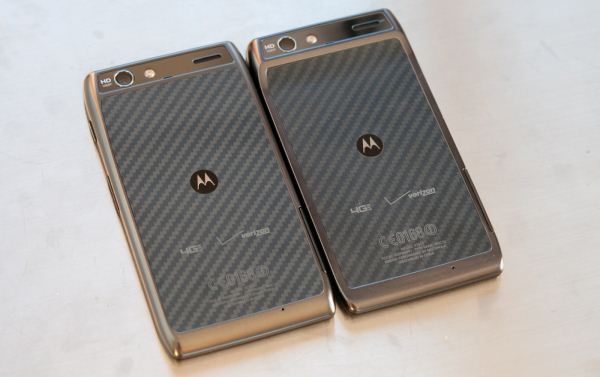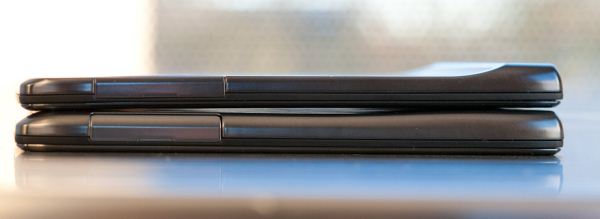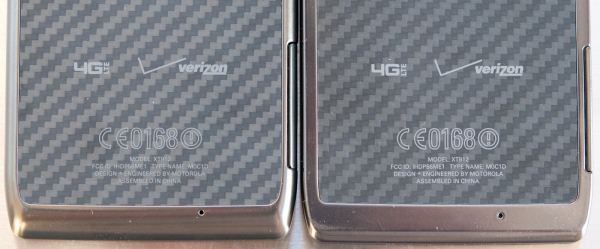Motorola Droid RAZR MAXX Review - 1.8x The Battery
by Brian Klug on February 14, 2012 2:01 PM EST- Posted in
- Smartphones
- Motorola
- Android
- Mobile
- motorola droid RAZR
- RAZR MAXX
- RAZR
Motorola Droid RAZR MAXX Review
For a while now, our chief complaint when talking about 4G LTE handsets has been battery life. The combination of 45nm cellular basebands, ever increasing screen size, and 4x nm SoCs has been unforgiving in the power department. Handset manufacturers are always engaged in a difficult balancing act between device size, price, and the resulting battery life. Too big of a battery and you’ve created a brick that looks unattractive next to other svelte phones, too small and you’ve created something that looks great but needs to be tethered to the wall all day.

Droid RAZR MAXX (left), Droid RAZR (right)
We’ve already reviewed the Motorola Droid RAZR, which itself is a close cousin of the Motorola Droid Bionic. As a result, we’re not going to go into super depth with the MAXX since it would be a 1:1 repeat in basically every part to what we talked about in the RAZR review already. The RAZR MAXX and RAZR are quite literally the exact same device (PCB, display, cellular basebands, camera, etc.) with the exception of battery and exterior case.
The two share the same model number (XT912), FCC-ID (IHDP56ME1), and run the same software. Motorola has talked about reducing the number of devices released yearly and consolidating down to just a few flagships, and though it’s easy to claim otherwise, the RAZR and RAZR MAXX don’t really confuse things that much since, again, they’re really the same phone with a different case and battery. The result of that similarity is that from a software and carrier testing perspective, delivering updates to one means delivering updates to the other, something we’ve already seen turn out to be the case with the recent 6.12.173 update.
What’s changed with the MAXX incantation is its battery, which is significantly larger. It seems as though Motorola has been feeling nostalgic about some of its old brands lately, reviving first the RAZR brand, and now the “MAXX” brand in the form of a moniker (anyone else remember the MOTORAZR MAXX?). In this case, what’s MAXX about the RAZR MAXX is its battery, which is 1.88 times the size of the RAZR battery. (As an aside, I can’t help but think of the Rage Fury MAXX every time I type MAXX)
The MAXX also continues use of Motorola’s higher voltage Li-ion chemistry, which is 3.8V nominal as opposed to the standard 3.7V nominal voltage. Motorola continues to use this higher voltage chemistry on a majority of its new devices. As I talked about in the Bionic and RAZR reviews, this means you can’t directly compare mAh, instead watt-hours is better for comparison purposes here. We’ve been careful about using Whr, and I only think in Whr anymore, which finally paid off with this jump to a higher voltage.
| LTE Smartphone Battery Size Comparison | ||||||
| HTC Rezound | CDMA/LTE Galaxy Nexus | Motorola Droid RAZR | Motorola Droid RAZR MAXX | |||
| Nominal Voltage | 3.7 V | 3.7 V | 3.8 V | 3.8 V | ||
| Capacity in mAh | 1620 mAh | 1800 mAh | 1750 mAh | 3300 mAh | ||
| Capacity in Watt-Hours | 5.99 Whr | 6.66 Whr | 6.65 Whr | 12.54 Whr | ||
Against the competition, the RAZR MAXX battery is positively huge, and is larger than the Bionic’s extended battery which itself was a hefty 10.2 Whr. The battery remains sealed inside and not easily replaceable, but given its size this is a totally acceptable trade-off. That’s really where the MAXX makes sense - if you’re going to sacrifice battery access and replaceability, it should be absolutely beyond a doubt big enough to make it through at least one day’s worth of constant abuse.

RAZR MAXX (bottom), RAZR (top)
The MAXX does put on some weight and get heftier in the midsection as a result, but the phone is still remarkably thin. What’s interesting is that although the RAZR MAXX is thicker than the RAZR at its thinnest point, the two phones’ thickest points are still the same. I guess that really illustrates what’s wrong with the way that OEMs are specifying device “thickness” these days more than anything, as most intentionally cite the device thickness at its thinnest point. One other OEM has told me it’s going to move to a mean thickness measurement, which seems to be more representative but potentially complicated. Personally, giving min and max seems to be the most honest disclosure, and again on the MAXX only the thinnest point gets thicker. Mass goes up 17 grams, just 13% over the RAZR.
| Physical Comparison | ||||
| Apple iPhone 4S | Samsung Galaxy Nexus (LTE) | Motorola Droid RAZR | Motorola Droid RAZR MAXX | |
| Height | 115.2 mm (4.5") | 135.5 mm (5.33") | 130.7 mm (5.15") | 130.7 mm (5.15") |
| Width | 58.6 mm (2.31") | 67.94 mm (2.67) | 68.9 mm (2.71") | 68.9 mm (2.71") |
| Depth | 9.3 mm ( 0.37") | 9.47 mm (0.37") | 7.1 mm (0.28") | 8.99 mm (0.35") |
| Weight | 140 g (4.9 oz) | 150 g (5.3 oz) | 127 g (4.5 oz) | 145 g (5.1 oz) |
| CPU | Apple A5 @ ~800MHz Dual Core Cortex A9 | 1.2 GHz Dual Core Cortex-A9 OMAP 4460 | 1.2 GHz Dual Core Cortex-A9 OMAP 4430 | 1.2 GHz Dual Core Cortex-A9 OMAP 4430 |
| GPU | PowerVR SGX 543MP2 | PowerVR SGX 540 | PowerVR SGX 540 | PowerVR SGX 540 |
| RAM | 512MB LPDDR2-800 | 1 GB LPDDR2 | 1 GB LPDDR2 | 1 GB LPDDR2 |
| NAND | 16GB, 32GB or 64GB integrated | 32 GB NAND | 16 GB NAND, 16 GB microSD class 4 preinstalled | 16 GB NAND, 16 GB microSD class 4 preinstalled |
| Camera | 8 MP with LED Flash + Front Facing Camera | 5 MP with AF/LED Flash, 1080p30 video recording, 1.3 MP front facing | 8 MP with AF/LED Flash, 1080p30 video recording, 1.3 MP front facing | 8 MP with AF/LED Flash, 1080p30 video recording, 1.3 MP front facing |
| Screen | 3.5" 640 x 960 LED backlit LCD | 4.65" 1280x720 SAMOLED HD | 4.3" 960 x 540 SAMOLED Adv. | 4.3" 960 x 540 SAMOLED Adv. |
| Battery | Internal 5.3 Whr | Removable 6.85 Whr | Internal 6.65 Whr | Internal 12.54 Whr |
In the hand, I find the MAXX to unsurprisingly feel very similar to the RAZR. The thickness change is obviously perceptible, but not a big deal. The RAZR remains a thin, flat device, and adding 2 mm at the thinnest point honestly doesn’t change the way that things feel to me. In the pocket, I think you’d have a hard time feeling the difference between the RAZR and the RAZR MAXX - neither print very much in a pair of jeans or dress slacks.
Interestingly enough the most notable change between the RAZR and the RAZR MAXX is that the two don’t lie flat the same way back down on a table. The RAZR tilts slightly thanks to that thickness difference, the RAZR MAXX is very close to being completely coplanar with the surface it’s resting on. The backside still has the slightly rubberized Kevlar material, though the curve at the top isn’t nearly as small. The microSD and microSIM door at the side gets a bit taller as well.
The RAZR MAXX is probably the first time I’ve seen a device offer a significantly larger battery without it being an obvious afterthought. The traditional extended battery upgrade path usually involves getting a new battery door with a huge, obvious, awkward bulge. Almost every single time, that battery door either doesn’t match or fit properly, or it’s just an awkward afterthought. The other upgrade option is usually a battery with the same volume but slightly more capacity. The MAXX is neither - a device with a notably bigger battery that doesn’t make all the concessions that normally accompany such an upgrade.

















45 Comments
View All Comments
mikael.skytter - Wednesday, February 15, 2012 - link
Thank you for another great review.As I was browsing through the phone benchmarks in the database the other week I noticed that this phone was listed there. Just out of curiosity, why was the benchmarks uploaded there before the review?
Best regards
Mikael
Ryan Smith - Wednesday, February 15, 2012 - link
Our backend is completely integrated, in this case our Bench system is tied into our graphing system. So we'll typically put a new product in Bench and then generate graphs from that, in which case if we don't set it to private mode it will show up in Bench before it's in an article.mikael.skytter - Thursday, February 16, 2012 - link
I see.Thank you for the reply.
Best regards
Mikael
shriganesh - Wednesday, February 15, 2012 - link
When will Motorola release a GSM version of this awesome device?? Waiting with my fingers crossed!Brian Klug - Wednesday, February 15, 2012 - link
I really hope they do as well, but there's no official word on when that device is coming.-Brian
Shadowmaster625 - Wednesday, February 15, 2012 - link
Well, its a start anyway. The device really isnt that much bigger. There is no reason why every device cant have at least 12 hours of web time. Unfortunately this translates into only two maybe 3 hours of playing a game that uses a 3d gfx engine after you've had the phone for a couple months.hifiaudio2 - Wednesday, February 15, 2012 - link
I assume still no update to the device or firmware to get rid of the rediculous neon green push? I took mine back as I couldnt stand the colors on the RAZR. I doubt they have any plans to change, though.doobydoo - Wednesday, February 15, 2012 - link
They seem to have taken an existing device, improved it dramatically with no real drawback, and addressed one of the major flaws with 4G Android phones.Great job Motorola.
lafrad - Wednesday, February 15, 2012 - link
I've went through 4 batteries and 2 handsets on the Rezound, and *never* got that battery life.4-5 hours with 1-2 hours of screen time on LTE was a MAX.... it would eek out 12 hours of standby time with no data sync (LTE on, why have the phone if LTE wasn't running?) ... and my LTE signal strength was often very good... Co-workers with a galaxy nexus sitting next to me, doing the same stuff, would *easily* get twice the battery life.
Would be interesting to see if you got a hand picked review unit or not...
kyuu - Thursday, February 16, 2012 - link
"Unsurprisingly we see an almost perfect 1.8x scaling here and get very close to the expected 21 hours of battery life you’d expect."